 |
| Jekyll Island Gatehouse |
|
An old postcard shows a banner hanging between a pair of gatehouses over Jekyll Island Road advertising the island as a year round beach resort. So it was and is.
Before we common citizens gained access to it by state fiat, Jekyll Island was an exclusive, hidden paradise for a select few of very wealthy 19th century respite-seekers. They called their hide-away "The Jekyl Island Club." (The spelling was later corrected to "Jekyll".) Visiting gardeners won't find original gardens. But Jekyll Island is blessed with wonderful vistas, well-maintained parterres, vibrant colors, container gardens, citrus trees and the magnificent Plantation Oak which is estimated to be over 350 years old. Follow me to see what remains of it behind those garden walls.
Before the Georgia Sea Islands drew vacationers,
Sir Robert Montgomery (1680-1731) planned a colony there to be named The Margravate Of Azilia. He assured prospective investors,
"That nature has not blessed the world with any tract which can be preferable to it; that Paradise, with all her virgin beauties, may be modestly supposed at most but equal to its native excellencies. lt lies in the same latitude with Palestine herself, that promised Canaan, which was pointed out by God's own choice, to bless the labors of a favorite people. It abounds with rivers, woods and meadows. Its iron, and even gentle hills are full of mines, lead, copper, some of silver.`Tis beautiful with odoriferous plants, green all the year. Pine, cedar, cypress, oak, elm, ash or walnut with innumerable other sorts, both fruit or timber trees, grow every where so pleasantly, that though they meet at top, and shade the traveller, they are, at the same time, so distant in their bodies, and so free from underwood or bushes, that the deer and other game, which feed in droves along these forests, may be often seen near half a mile between them."
Sir Robert didn't live to see the margravate established, but two years after his death, General James Edward Oglethorpe, funded by rich investors (some named as "Trustees"), led a group of freed debtors to establish the colony of Georgia. It was better for the debtors to work for themselves than languish in prison. The investors, of course, aimed to see a substantial return on their money. The Trustees funded all kinds of horticultural experiments. They supported whatever they thought would succeed in "Palestine herself", including vineyards, silkworms, and exotic fruits. Cotton prospered.
The Trustee's Garden is now mostly a parking lot partly owned by the Episcopal Diocese of Georgia. The Episcopal Church is failing.
General Oglethorpe understood the dangers of Spanish in
La Florida to England's colonial interests, so he established a system of forts and towns as a buffer for protection of Savannah. This island was known to the Spanish as Isla de Ballenas or "Island of Whales". Why was it named
Isla de Ballenas? I don't know. There must have been a lot of migratory whales nearby at the time. The Spanish may have marked it as a good place for hunting, but whaling never became an industry along the coast. Anyway, the Spanish lost. (Whales are occasionally spotted offshore.) Oglethorpe renamed the island in honor of Sir Joseph Jekyll, a financial supporter.
Sir Joseph Jekyll, a man of compassion and conviction, may be best known for his war on poverty. As a member of the British Parliament, he introduced a heavy tax on gin. The proceeds were to fund programs to aid the poor. But, like those of most politicians, his schemes ended up hurting most those he intended to help. The wealthy preferred wine and beer. The poor drank gin. The poor lost. Riots resulted and Sir Joseph had to be protected from the mobs. Sir Joseph lost.
Since colonial times, the Georgia Sea Islands have attracted planters, industrialists, bankers, lawyers, investors, entrepreneurs and vacationers in droves. In 1886, a group of rich industrialists purchased the island for $125,000 from John Eugene DuBignon, a descendent of an earlier planter. You can read more about
DuBignon fortunes and losses at the New Georgia Encyclopedia. John DuBignon's brother-in-law, Newton Finney, had connections in New York and had great plans for development. Finney contacted his friends. They bought the island and established a hunting retreat, so the
Jekyll Island Club was born. One hundred shares in the Club were sold to only 50 selected members to preserve its exclusivity.
Early on, memberships were by invitation only. The founding group determined to whom it would sell shares, mostly within their circles. Later on, memberships were approved by a board. During the Great Depression, the directors decided they should open the Club to more members, so they designed Associate memberships at more affordable rates to accommodate just about anyone who had enough.
Over the years, share owners included such notables as George F. Baker, M.C.D. Borden, Charles R. Crane, Charles Deering, Frank Goodyear, Edwin and George J. Gould Sr., Henry Hyde, Marshall Field, John Pierpont Morgan, Joseph Pulitzer, William Rockefeller, Theodore N. Vail and William H. Vanderbilt. An imposing Clubhouse was constructed, and officially opened in 1888. Several families had cottages built for themselves. Some lived in the Sans Souci apartment complex. Recreational facilities included a golf course and a tennis court.
The Jekyll Island Club was not without a Christian chapel. Faith Chapel, though not the largest building, says something about those Jekyll Island Club members. It's a simple wood building adorned with a few gargoyles (gargoyles?) and two important windows. One was created by Maitland Armstrong and his daughter, Helen. The other was created by Louis Comfort Tiffany. Worshiping in
Faith Chapel lit by the colors of Armstrong and Tiffany must be comfortable, indeed. Why did they establish this chapel? To the glory of God, I expect. Whether they could recite the catholic creeds with faith without lying, I can't judge. I can only conclude that, at least, they acknowledged the Triune God with appropriate nods and tithes, or maybe much more.
With such a group of American "movers and shakers", the Jekyll Island Club became a site of historical significance. Following the banking panic of 1907, a super-secret "duck hunt" meeting of Sen. Nelson Aldrich (RI), Dr. A. Piatt Andrew, Henry P. Davison, Frank A. Vanderlip and Paul M. Warburg occurred at the Club in 1910.
Accounts of the meeting are fascinating. They bagged no ducks, but, for better or worse, they hatched what is now the Federal Reserve System.
On January 25, 1915 Theodore N. Vail, the first president of AT&T, participated from Jekyll Island in the opening of the
first transcontinental phone call across the U.S. The party-line call included Vail, Welles Bosworth, S. B. P. Trowbridge, J. P. Morgan, Jr., and William Rockefeller on Jekyll Island, Alexander Graham Bell in New York, Thomas A. Watson in San Francisco, and President Woodrow Wilson in Washington, D.C.
The Great Depression of 1929, heavy taxation on the wealthy, and World War II made it difficult to maintain interest in the Jekyll Island Club. Members were not allowed to visit during World War II due to security concerns. Membership dropped off and the Club was nearly abandoned. In 1946, the State of Georgia decided it wanted to establish a state park on one of its barrier islands, so Jekyll Island was purchased through a condemnation order for $675,000. Surprise! Club members lost.
The Jekyll Island Club was turned into a public resort, but the state of Georgia couldn't manage to turn a profit. Not surprisingly, the government's scheme was a financial disaster, so the resort was closed in 1971. Georgia taxpayers lost.
Radisson Hotels bought, refurbished and re-opened Jekyll Island Club in 1985. After a few years, Radisson sold it.
Jekyll Island Club Hotel is now owned and operated by
Historic Hotels of America, a Preferred Hotel Group brand, which is a program of the National Trust for Historic Preservation.
Rambles through The Jekyll Island Club will allow visitors enticing glimpses into America's Gilded Age. The interesting cottages often had the most modern conveniences of the time. Though the cottages were simple compared to their owners' homes up North, Club members weren't really roughing it.
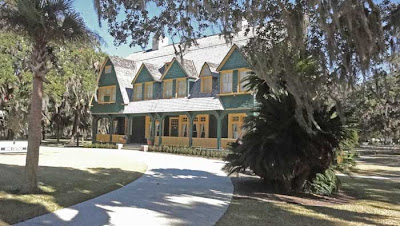 |
| Moss Cottage |
|
|
Moss Cottage was built in "shingle-style" for
William Struthers Jr. (1848-1911) in 1896, later owned by George Henry Macy (1858-1918) and family. Struthers was co-owner of one of the nation's most important marble firms. Geo. H. Macy and Co. imported tea from China and Japan. The company was later expanded to become The Atlantic and Pacific Tea Company, the parent company of A & P Stores. An interesting feature of Moss Cottage is the folk art in a dormer displaying the year of its construction.
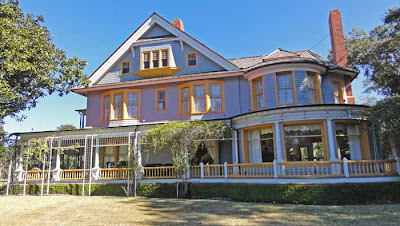 |
| Indian Mound College |
|
|
Indian Mound Cottage (originally known as the McKay Cottage) was built in 1891 for
Gordon McKay (1821-1903) of Pittsfield, MA. McKay began his fortune by capitalizing on an invention he had observed that manufactured shoes for Union soldiers. McKay's estate sold the cottage to
William A Rockefeller, Jr. (1841-1922) of Standard Oil fame in 1905. During Rockefeller's time, the cottage was expanded. Rockefeller also maintained an apartment at the Sans Souci, nearby.
Following William's death, Indian Mound Cottage was purchased by Helen Hartley Jenkins (1860-1934), widow of George Walker Jenkins (1847-?). Her husband had been the president of American Deposit and Loan Company. Mrs. Jenkins, a leading philanthropist of the time, founded the School of Nursing at Teacher's College of Columbia University. Even a few peeks through the windows give hints at the gracious living that the residents must have enjoyed. On display outdoors is a Red Bug, an
open-air vehicle of the type used by many Jekyll Island Club members to whizz around the island. (If you visit Jekyll Island, you can rent new-fashioned electric Red Bugs to scoot about.)
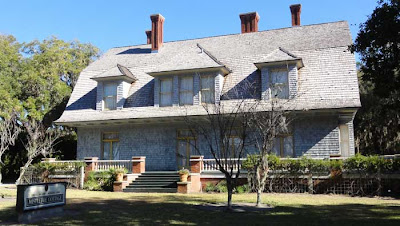 |
| Mistletoe Cottage |
|
|
Mistletoe Cottage was built in 1900 by
Henry K. Porter (1840-1921) of Pittsburgh. Porter was a manufacturer of light locomotives, elected to be a member of Jekyll Island Club in 1891. He served as a U.S. Congressman from 1903 to 1905. His company is now H.K. Porter Company, Inc., manufacturer of various industrial products. Mistletoe Cottage is a Dutch Colonial cottage with elements of shingle and classical styles. Though called a cottage, it includes 15 rooms and 5 bathrooms. This is one of my favorite rooms.
John Claflin (1850-1938), an original member of the Club, rented and later purchased Mistletoe Cottage from Porter's estate. At one point, Claflin was the leading dry goods merchant in the United States. The cottage is minimally landscaped today with Cherokee roses, aspidistra, sword ferns and camellias.
John Eugene DuBignon, the former owner of Jekyll Island, was also a member of the Jekyll Island Club. His farmhouse, built in 1884 before the island was purchased by the Club, was less ostentatious than most others. Early on it housed the Club's Superintendent and guests. It's not located at its original site, but was moved in 1896 to make room for the Sans Souci Apartments. Landscaping is simple, not unlike what you'd find around some homes today.
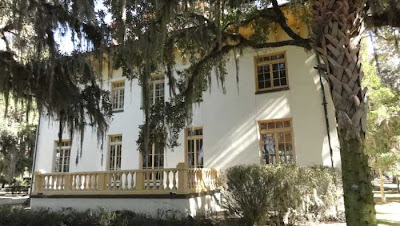 |
| Goodyear Cottage |
|
|
The Goodyear Cottage, built in 1906 in Italian style, was constructed for
Frank Henry Goodyear (1849-1907) of Buffalo, New York. Goodyear started work as a bookkeeper for Robert Looney, who owned large tracts of timberland in Pennsylvania. Eventually he married Looney's daughter, Josephine, and saw to it that her inheritance would include her father's timber interest. When Looney died, Goodyear began a partnership in a lumber company. It was a very lucrative enterprise, and Goodyear amassed a fortune. Unfortunately, Goodyear died a year after his Jekyll Island cottage was completed. His family, however, used it for many years. It now serves as a gift shop, art gallery and museum. Landscaping is minimal and unremarkable.
 |
| Cherokee Cottage |
|
|
Cherokee Cottage, also known as the Shrady-James Cottage, was built in 1915 by
Edwin Gould (1866-1933), the son of notorious financier
Jay Gould (1836-1892), for his mother-in-law, Mrs. Hester E. Cantine Shrady (1842-?). Mrs. Shrady was the widow of
Dr. George F. Shrady (1827-1907) of New York. Dr. Shrady was Assistant Surgeon, U.S.A, during the War Between the States. Cherokee Cottage, built in Italian Renaissance style, has 20 rooms and 8 bathrooms. These include 12 bedrooms and 2 kitchens (one for the servants).
It was last owned by Dr. Walter Belknap James of New York (1858-1927). Dr. James was consulting physician at Bellevue Hospital, New York, and president of the national committee for Mental Hygiene.
 |
| Hollybourne Cottage |
|
|
|
Hollybourne, designed by William Day, is one of the most architecturally unique buildings at Jekyll Island Club. The style is known as pseudo-Jacobean with Flemish gables, paired chimneys and patterned stone work. Built in 1890, Day utilized tabby, a native material made of oyster shells. The owner, Charles Stewart Maurice (1886-1924), was a bridge engineer and partner in the
Union Bridge Company of Athens, PA. Maurice included some elements using bridge engineering techniques which included a steel support system, brick piers in the basement, and trusses designed to distribute the weight of the living and dining room ceilings without the use of support beams.
On the first floor there was a parlor, 2 dining rooms (one for the servants), kitchen, pantry and storage rooms, and lavatory. There were 9 bedrooms and 4 bathrooms upstairs. The Maurice family visited the house every year, except for 1894 and 1895 due to yellow fever epidemic.
When the state tried to condemn the island for a state park, the Maurice sisters, heirs to the property, were outraged. They had sojourned at Hollybourne for over 50 years. They sued the state, but lost. Though they received payment for more than the property was initially assessed, the Maurice sisters were so livid that they never returned to Georgia. Even when en route to Florida, they would intentionally detour through Alabama to avoid setting foot on Georgia soil.
Incidentally, local lore has it that Hollybourne is haunted by the Maurice sisters. Each time attempts are made at renovation, workers return to find their work mysteriously dismantled and thrown in the yard.
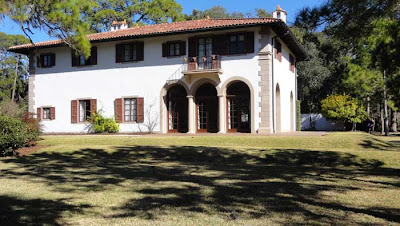 |
| Villa Ospo |
|
Villa Ospo was built in 1928 by Walter Jennings (1858-1933), director of Standard Oil Company of New Jersey. Jennings was the brother Mrs. Gordon Auchinclose, Mrs. Walter Belknap James, and Miss Annie Jennings, who were also Club members. Villa Ospo has twenty rooms, including ten bedrooms and five bathrooms. Gardeners today will be attracted to the large patio with a lily pool and fountain, and the fruitful kumquat trees.
|
 |
| Villa Marianna |
|
|
|
Villa Marianna, completed in 1929, was the home of Frank Miller Gould (1895-1945). Frank was the son of Edwin Gould, Sr., owner of Cherokee Cottage. Villa Marianna is more modest than some of the other cottages. Nevertheless, attractive landscape features include an extended water garden with fountains and an enclosed courtyard.
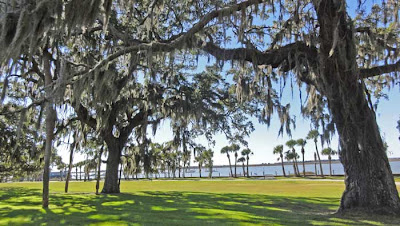 |
| Intracoastal Waterway |
|
|
|
Many of the Jekyll Island Club cottages are within view of the Intracoastal Waterway. The river, of course, afforded residents and guests delightful vistas and breezes. Today's visitors are no less fortunate in that regard than the Club members of the 19th century. To slightly re-state Superintendent Grob's comment in 1914, "I think if
visitors could see Jekyll as it is today, they would say that they can find no spot on earth any better."
Return to
GoGardenNow.com.



















